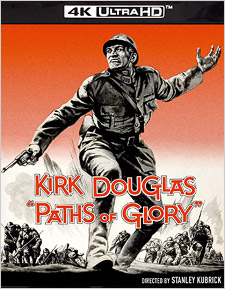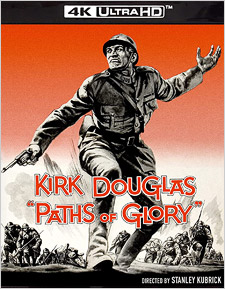Paths of Glory (4K UHD Review)

Director
Stanley KubrickRelease Date(s)
1957 (August 23, 2022)Studio(s)
Bryna Productions/Harris-Kubrick Pictures/MGM/United Artists (Kino Lorber Studio Classics)- Film/Program Grade: A
- Video Grade: A+
- Audio Grade: B
- Extras Grade: B-
Review
Cinephiles have long held an appreciation for films that examine the horrors of war, not just for the sheer spectacle but also for their deeper emotional resonance. And while Stanley Kubrick’s Paths of Glory may have lost a measure of its impact with age (this particular conflict ended, after all, more than a century ago), it still ranks well among the best films of the genre, chiefly because it depicts the full range of human experience and reaction—greed, fear, cowardice, bravery, honor—in such difficult circumstances.
Its events take place in France, among the soldiers of the French Army, during the first World War. When an order is handed down by the High Command that a particularly difficult German position (called “the Anthill”) is to be taken immediately and at all costs, the commanding officer of the solders tasked to do do, General Mireau (George Macready), at first resists the idea. He knows full well that the losses among his troops in such an attack, without reinforcements, will be overwhelming. But when the right incentive is applied—in this case, a little flattery and a significant promotion—the general’s reluctance begins to disappear. The order is thus handed down to the regiment commander who will actually lead the attack into no man’s land, Colonel Dax (Kirk Douglas).
Dax immediately recognizes the sheer folly of the assault, but threatened with being sent on leave if he chooses not to enthusiastically support the attack, he relents. When zero-hour arrives, Dax bravely leads his men into the line of fire, where most are cut to pieces. And due to the cowardice of one of his lieutenants, some of his troops never leave the trenches. The general, furious with the result, decides that the attack failed because Dax’s men have “milk running through their veins.” So it’s decided that three of the men will be chosen at random, regardless of their actions during the battle, and will be placed on trial for cowardice and mutiny—a charge that could mean death if they’re found guilty. Dax, a lawyer before the war, must now defend his men in the volatile battlefield of a military court-martial, and fight behind-the-scenes politics to prevent what is otherwise destined to become a mockery of justice.
Paths of Glory a terrific film. Kubrick’s script (co-written by Jim Thompson and Calder Willingham, based on the novel of the same name by Humphrey Cobb), raises a number of issues of morality and human nature without being too heavy-handed. This narrative could easily have dissolved into a courtroom drama, but instead focuses on the actions (and reactions) of the men affected by the court’s decisions—we actually spend very little time in the courtroom itself.
Kirk Douglas excels in the role of Dax, lending the character an honest confidence early on, while later delivering one his best-ever lines of dialogue on film with full, vein-popping venom. Cinephiles will already know that the young German singer in Paths of Glory was played by Susanne Christian, who eventually became Kubrick’s wife Christiane. Sharp-eyed viewers may also recognize that Mireau’s aide de camp was played by Richard Anderson, better known to TV viewers in the 1970s as Oscar Goldman on The Six Million Dollar Man.
While this film certainly isn’t Saving Private Ryan, the realism that Kubrick and cinematographer Georg Krause managed to evoke during the assault sequence is completely believable, emulating actual combat newsreel footage—quite a feat considering the film was made in 1957, without modern digital effects. (It’s also important to remember that the footage was shocking to audiences of the day.) And despite its discomforting tone, the film’s ending manages to restore just the right measure of hope to both Dax and the viewer alike.
Paths of Glory was shot on 35 mm B&W film using Arriflex 35 IIA and Mitchell cameras with spherical lenses, and was finished at the 1.66:1 aspect ratio for theaters. For its release on Ultra HD, Kino Lorber Studio Classics has made use of a recent 4K scan of the original camera negative and have graded the result for high dynamic range (both Dolby Vision and HDR10 are available). The result is a striking image, crisp and finely-detailed save for a few shots that exhibit soft focus. The added resolution lends a gritty immediacy to the soldiers’ experience of trenches and battlefields, while enhancing the contrasting decadence of the French chateaus the generals inhabit. Muddy uniforms, unshaven faces, roughly-cut wooden trench bracings, gleaming medals and dress uniform ornamentation—all of it looks better here than ever before. Photochemical grain is medium to strong (a bit more coarse early on in the film), but organic at all times and entirely appropriate to the film. The wider gamut of HDR produces deeply black shadows, with pleasing texture therein, while highlights have a boldly oppressive glow. While this is not a perfect image in a traditional or modern sense, it’s a magnificent presentation for this particular film, improving upon the previous Criterion Blu-ray in both detail and refinement. Paths of Glory has simply never looked better than it does in 4K UHD.
Audio is provided in English 2.0 mono in DTS-HD Master Audio format. It’s hardly a standout mix from a home theater standpoint, but it serves the film very well indeed, with clean and clear dialogue throughout. During the battle sequences, there’s plenty of rumbling shell blasts, howling artillery, and shrill gunfire, as one would expect. Optional English SDH subtitles are included.
Kino Lorber Studio Classics’ 4K UHD release includes only a few extras, but they’re all worth having:
- Audio Commentary by Tim Lucas
- Paths of Glory Trailer (HD – 3:00)
- Killer’s Kiss Trailer (HD – 1:46)
- The Killing Trailer (HD – 1:46)
The engrossing commentary by critic and historian Tim Lucas (of Video Watchdog fame) is presented as a kind of audio guide to the film, offering thoughtful analysis and an abundance of trivia, background information, and other production and historial detail. The film’s trailer is also included in good HD quality given its age, as are trailers for two other early Kubrick films (both of which are also available in 4K Ultra HD from Kino Lorber Studio Classics). Note that the first part of a couple of these trailers plays out with audio only over a black screen—that’s not an error.
Better war epics have been made since Paths of Glory was first released, but the film remains powerful and poignant to this day, and was certainly director Stanley Kubrick’s first genuinely great work for the big screen. Kino Lorber Studio Classics has delivered a fine 4K Ultra HD release of the film, with best-ever image quality on disc. This release is must-have upgrade, highly recommended for Kubrick fans and cinephiles alike.
- Bill Hunt
(You can follow Bill on social media at these links: Twitter and Facebook)

